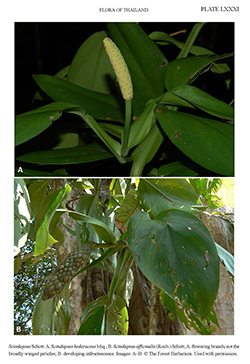e-Flora of Thailand
Volume 11 > Part 2 > Year 2012 > Page 292 > Araceae > Scindapsus
1. Scindapsus hederaceus Miq.
Fl. Ned. Ind. 3: 185. 1856; Schott, Prodr. Syst. Aroid.: 395. 1860; Engl. in A.DC. & C.DC., Monogr. Phan. 2: 253–253 (‘hederacea’). 1879; Hook.f., Fl. Brit. India 6: 542 (‘hederacea’). 1893; Engl. & Krause in Engl., Pflanzenr. IV, 23B (Heft 37), 75–77, fig. 32,E–N. 1908; Ridl., Mat. Fl. Malay Penins.: 38–39 (‘hederacea’). 1907; Fl. Malay Penins. 5: 117–118. 1925; Gagnep. in Lecomte, Fl. Indo-Chine 6: 1105–1106. 1942; Hu, Dansk Bot. Ark. 23: 420. 1968. Plate LXXXI: A.
Accepted Name : This is currently accepted.
Synonyms & Citations :
Description : Medium to large, moderately robust, leptocaul, homeophyllous secondary hemiepiphyte to 10 m. Stems terete, ca 1.5 cm diam., epidermis pale green, drying pale brown and remaining intact. Leaves rather regularly arranged on climbing stems, tending to cluster towards tips of flowering stems; petiole prominently winged, 7–12 by 1–2 cm, apical and basal pulvini weakly defined; petiolar sheath very prominent, spreading and wing-like, persistent, briefly ligulate at apex; leaf blade lanceolate-elliptic to linear-lanceolate, slightly to markedly oblique, 12–17 by 2–4 cm, thinly coriaceous, base subacute usually oblique with one side slightly auriculate and the other somewhat cuneate, apex acute to attenuate, with a prominent apiculate tubule, pale green, slightly glossy, juvenile leaves frequently with moderate to extensive, silvery, longitudinally banded variegation; midrib raised abaxially, slightly sunken adaxially; primary lateral veins pinnate, slightly raised abaxially and adaxially; interprimaries parallel to primaries and only slightly less prominent, very slightly raised abaxially and adaxially; secondary and tertiary venation ± obscure in fresh material, visible as a faint reticulum in dried specimens. Inflorescence solitary, very rarely 2 together, arising on free lateral and less often adherent shoots, subtended by a fully developed foliage leaf; peduncle compressed-cylindrical, 4–8.5 by 0.5–0.75 cm; spathe broadly cigar-shaped, 7.5–9 by 1–3 cm, very long, stoutly beaked, thinly stiff-fleshy, dull yellow, paler internally, caducous at pistillate anthesis; spadix cylindrical, 3–6 by 1–2.5 cm, sessile, inserted ± level on peduncle; stylar region mostly longitudinally rhombohexagonal, 3–4.5 by 12–2 mm, truncate; stigma longitudinally elongated, flush, ca 2 mm. Infructescence stoutly cylindrical, 6–8 by 2–2.5 cm, edges of stylar plates recurving and the whole somewhat waxy in appearance, ripening dull yellow.
Thailand : NORTH-EASTERN: Khon Kaen; EASTERN: Chaiyaphum; PENINSULAR: Ranong, Phangnga, Satun, Narathiwat.
Distribution : Indochina (type of Scindapsus poilanei) to W & C Malesia, including Sumatra, Java (type and types of S. pothoides and S. pothoides var. angustata), and Borneo (type of S. inquinatus).
Ecology : Dry evergreen forests, very rarely in peat swamp forests, on sandstone, sometimes on limestone.
Vernacular : Kho kio (คอกิ่ว)(Peninsular).
Notes: Scindapsus hederaceus is distinctive by the strongly winged petioles and narrowly lanceolate, often falcate leaf blades. It is most similar to S. officinalis but readily separated by the narrower leaf blades and the fact that the stem epidermis dries pale brown and remains attached in dry material whereas that of S. officinalis dries distinctively orange-brown and readily flakes away.

